|
|
|
|
 |
| Site Contributors |
 |
 |
| Studio Borlenghi |
 |
 |
 |
| Michael
McCoy |
 |
 |
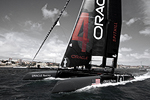 |
| Morris Adant |
 |
 |
 |
| Peter
Andrews |
 |
|
|
| |
|
| Save it for the second half. |
| By Jim Gale, Rolex Sydney Hobart media team. |
 |
Photos by
Peter Andrews,
Story edited By Peter Andrews. |
| 18:00 AEDT December 26, 2010. |
 |
The Sydney Hobart is shaping up to be two quite distinctive races wrapped into one; the first half, from Sydney Heads to Flinders Island on Tasmania’s north-eastern tip and the second, from Flinders to the finish in the Derwent River.
As the fleet settled into a broad reach on flat seas in the early hours after the start, in the back of everyone’s mind was the classic southerly buster waiting for them further down the coast. The breeze swung around the dial from the west to the east, and at 5.30pm this evening, the front runners had run into the first of three anticipated southerlies and had shifted gears accordingly. |
 |
Alan Brierty's Reichel Pugh 62 Limit offshore Sydney and chasing the
leaders after the start of the 2010 Sydney Hobart Yacht Race.
Photo © Peter Andrews, Outimage Australia.
|
 |
|
 |
The southerly is likely to intensify overnight, with the worst conditions of the Cruising Yacht Club of Australia conducted race, anticipated in a 12 hour stretch tomorrow.
Wild Oats XI skipper Mark Richards expects Bob Oatley’s 30-metre long supermaxi to be entering Bass Strait around 9am tomorrow, which is when they are likely to launch into south to south-westerly winds of up to 35 knots and steep, lumpy seas. By Monday night, life on board will be a proverbial washing machine. The drivers’ job will be to get the boats down to Flinders Island in contact with their rivals, while keeping them in one piece. |
 |
Bob Oatley's 100 footer Wild Oats XI, after rounding the seaward
mark and well on the way to Hobart, during the 2010 Sydney Hobart
Yacht Race.
Photo © Peter Andrews, Outimage Australia.
|
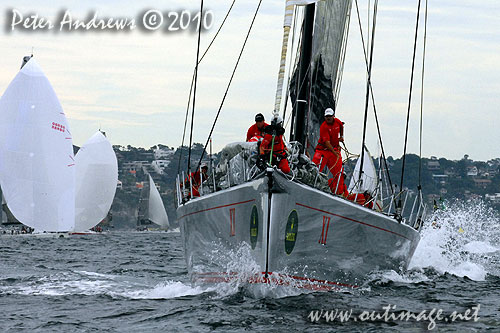 |
|
 |
Unlike other Sydney Hobarts, where constant wind shifts and changes have kept them on their toes for the full 628 nautical miles, this year they really only have one big decision to make in this first installment of the race. And that decision is basically What angle do they want to enter Bass Strait on?
Once in the lee of Tasmania the second race begins: the navigators’ race. In difficult to predict conditions, they will have to make the tactical decisions that will either win the Tattersalls Cup, or lose it.
"You will be able to lose the race in the first 300 miles," says Will Oxley, the navigator of Rodd & Gunn Wedgetail, "but not win it. The second half, off Tasmania, is where the race will be won and lost." |
 |
Bill Wild's Reichel Pugh 55 Rod & Gunn Wedgetail from Queensland,
ahead of the start of the Sydney Hobart 2010.
Photo © Peter Andrews, Outimage Australia.
|
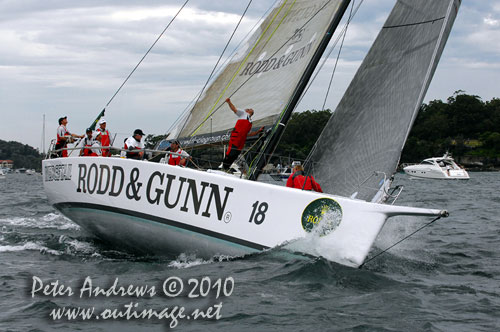 |
|
 |
One bad call can leave a yacht becalmed with a mocking breeze pushing her rivals past her just a couple of miles away. Ironically, while this will be the time for the navigators and tacticians to star, it is also precisely the half of the race when the boat drivers will need to lift their game up an extra gear.
Cold, wet and tired after some 36 hours of drenching watches perched on the rail, crews will need to find the reserves to drive themselves and their boat just that bit harder than anyone else, putting in that extra sail change, executing maneuvers with the same precision as they do on a day’s sprint around the buoys.
"You’ve got to be 95 per cent fighting fit on the Tasmanian coast, otherwise you’re out," says YuuZoo skipper Ludde Ingvall. "Managing tiredness will be a huge part of every skipper’s job in the first half of the race." |
 |
Ludde Ingvall's 90 foot maxi YuuZoo and Niklas Zennström's Rán,
outside the heads after the start of the Sydney Hobart 2010.
Photo © Peter Andrews, Outimage Australia.
|
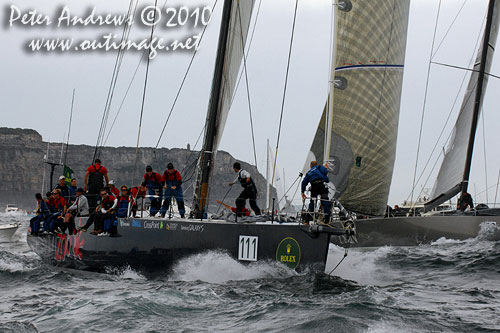 |
|
 |
Former overall winner Ed Psaltis with AFR Midnight Rambler and Ingvall agree that the crews that do best will be the crews that are most disciplined during those testing first 300 miles.
"We run a very disciplined watch system. I really make sure that when the guys are off watch they are in their bunks," says Ingvall.
"It’s about maintaining the watch system rigidly so that those below don’t get interrupted when they are resting," agrees Psaltis, skipper of his modified Farr 40. "You need to keep the food up, give them coffee when we can, plenty of water. It is also really important to keep the boat dry down below, so that when the crew come down off watch, they can get into some dry clothes and warm up. The cold is very exhausting. We’ll have to do everything we can so that when the breeze finally eases we will be in good shape. We’ll be tired, It’s just a case of trying to manage how tired we are." |
 |
Ed Psaltis' former overall winner AFR
Midnight Rambler, offshore
Sydney after the start of the Sydney Hobart 2009.
Photo © Peter Andrews, Outimage
Australia.
|
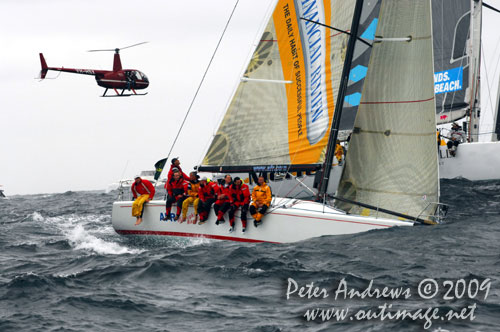 |
|
 |
"You’ve also got to be disciplined with the boat too," Ingvall says. "Don’t push it when you don’t have to. You can break the boat in one second, but it is the last two hundred miles that matter."
That is certainly how Ingvall and his fellow maxi skippers will approach the first half of the race. Sean Langman, the skipper of Investec Loyal explained pre-race. "There is a time when boat racing stops and seamanship takes over and certainly with the big boats, there will be more seamanship than boat racing until we get the other side of the southerlies."
Oddly enough, the boat that wins line honours may well be the boat that chose to slow down at the right time. But Ed Psaltis is not sure the handicap contenders have that option.
"We need to be relatively competitive in those first two days because, unlike the line honours boats where only three can really win, in handicap there are more than 50 boats out there with a chance. You can’t take your foot off the accelerator like those big yachts can, because none of those 50’s will and you’ll lose the race to them." |
 |
Sean Langman and Anthony Bell’s Investec Loyal, ahead of the start
of the 2010 Sydney Hobart Yacht Race.
Photo © Peter Andrews, Outimage Australia.
|
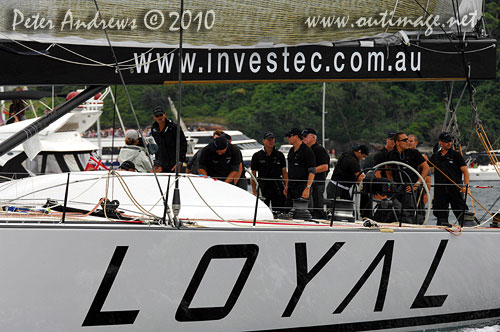 |
|
 |
Oddly enough, while the conditions will be uncomfortable, strong consistent headwinds mean fewer sail and course changes than a flukier race, and that will help a lot according to Oxley.
"We run a three-watch system on a two hour rotation, two hours on, two on standby, two below, but the reality is, that when you are going upwind in those conditions, you only need the one watch on deck and the standby watch can be sleeping in the windward bunks down below."
Oxley stresses that keeping the crew well fed in difficult circumstances is vital.
"We have changed the whole routine of what and when we are going to eat around the forecast. We have shifted it round so that when we are in Bass Strait we’ll just have the freeze dried food that is easy to prepare, and we’ve changed the snack food we’ll take so that if it is too rough to eat, we have a whole series of hi-protein snack foods." |
 |
Bill Wild's Reichel Pugh 55 Rod & Gunn Wedgetail from Queensland,
ahead of the start of the Sydney Hobart 2010.
Photo © Peter Andrews, Outimage Australia.
|
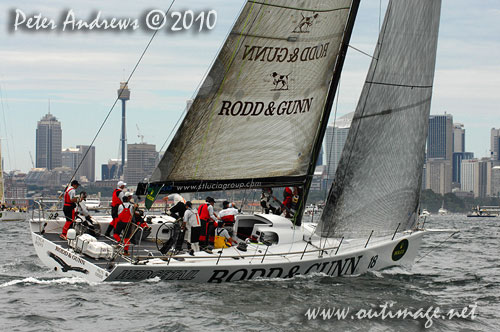 |
|
 |
Not that everyone will be thinking of food. "Seasickness is going to be a problem," says Psaltis. "There will be plenty of boats with seasick crew. We’ve got a smaller crew, so if two or three of them get sick, it changes the whole dynamic of the boat. For some boats it will be a matter of managing seasickness and having crew that are tough enough to push through that rather than roll over and die."
With such a tough race forecast there was not much scope for Christmas indulgence for the thousand odd Sydney Hobart competitors this year. "We’ve had easy races since 2004, so I’ve been able to look at the forecast and think, ‘right, I can have a few drinks and get into the tucker and I won’t get bashed around too much for the first few days’," laments race veteran Ed Psaltis. "I got away with it then, but this year I watched myself very carefully on Christmas Day."
"I had a little chat with the crew about on Christmas Eve," says Ingvall. "Stay light on the alcohol and try to focus on solids. Christmas pudding can be good. It can hold everything together. Generally it’s the matter of sleep that is the biggest problem," he told his young crew. "Load up on sleep." He’ll know who was listening, later this evening. |
 |
Ludde Ingvall's 90 foot maxi YuuZoo, at the heads and heading offshore
after the start of the Sydney Hobart 2009.
Photo © Peter Andrews, Outimage Australia.
|
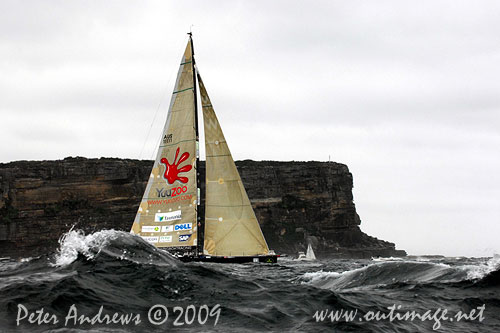 |
|
 |
For further information about the Sydney Hobart Yacht Race, go to: www.rolexsydneyhobart.com. The race can also be followed on Twitter at: http://twitter.com/rshyr.
To see the full sequence of photos of the start from the water, go to: http://bit.ly/f5r2Wu. |
 |
| Outimage © 2010 |
|
|
|

